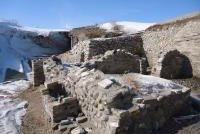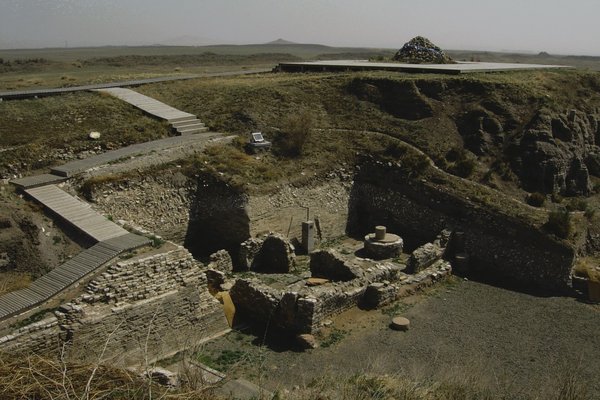China
Site of Xanadu
The Site of Xanadu encompasses the remains of Kublai Khan's legendary summer capital of the Yuan Dynasty.
The grassland capital at the edge of the Mongolian plateau includes the former city with temples and palaces, water control works, tombs, and traditional ovoo (stone cairn) shrines of the Mongolian nomads. Its plan shows a mix between Mongolian and Han Chinese traditions. It is also the place from where Tibetan Buddhism expanded over north-east Asia.
Community Perspective: It’s far from everywhere and you’ll need to take a taxi for the last 20km. However, the archeological site is fenced, requires an entrance fee and has multilingual signs. Michael found few remains from the Yuan Dynasty but imagined how the Mongols on horses entered the city after each victory in war.
Site Info
Official Information
- Full Name
- Site of Xanadu (ID: 1389)
- Country
- China
- Status
-
Inscribed 2012
Site history
History of Site of Xanadu
- 2012: Revision
- Formerly on Tentative List as Historical Remains at Yuan Shangdu (1996)
- 2012: Inscribed
- Inscribed
- 1981: Deferred
- At Bureau - Concern regarding Dam (As former TWHS Historical Remains at Yuan Shangdu)
- 1980: Deferred
- As former TWHS Historical Remains at Yuan Shangdu
- Type
- Cultural
- Criteria
- ii
- iii
- iv
- vi
Links
- UNESCO
- whc.unesco.org
- Official
-
- travelchinaguide.com — Xanadu
All Links
UNESCO.org
- whc.unesco.org — whc.unesco.org/
Official Website
- travelchinaguide.com — Xanadu
News Article
- May 8, 2016 english.eastday.com — Site of Xanadu Museum opens for public in Inner Mongolia
- May 31, 2015 livescience.com — Dragons of Xanadu: Sculptures Discovered in Legendary City
Community Information
- Community Category
- Archaeological site: Far Eastern
Travel Information
Recent Connections
-
Fusion
"From Xanadu, the mounted warriors of K… -
Canals
Remains of the Tiefan’gan Canal -
Chinese Garden
Beiyuan, the garden where the Yuan Dyna…
Connections of Site of Xanadu
- Individual People
-
-
Marco Polo
opened eyes of the world to China and the marvels of Xanadu (AB ev)
-
- History
-
-
Fusion
"From Xanadu, the mounted warriors of Kublai Khan unified the agrarian civilisations of China, and partly assimilated to the latter’s culture, while extending the Yuan empire right across North Asia. The plan of Xanadu, with Palace and Imperial cities enclosed partly by the Outer City containing evidence of the nomadic encampments and royal hunting enclosure, comprises a unique example of this cultural fusion. " (AB ev) -
Located in a Former Capital
From 1274, Xanadu became Kublai's summer capital (Capital of the Yuan Dynasty) -
Silk Roads
Mongolian route; "an important stopping place on the silk route" (AB ev)
-
- Architecture
-
-
Chinese Garden
Beiyuan, the garden where the Yuan Dynasty grew exotic and rare plants and cultivated unusual animals and birds (described by Marco Polo)See en.wikipedia.org
-
Glazed tiles
glazed tiles were found (AB ev) -
Geomancy
-
- Religion and Belief
-
-
Taoism
The city hosted a major debate between Buddhism and Taoism in the 13th century (AB ev) -
Tibetan Buddhism
Tibetan Buddhist lama temple Qianyuan Temple (1274) (AB ev)
-
- Human Activity
-
-
Irrigation and drainage
water control works (AB ev) -
Festivals
Kublai Khan held special feasts for the Mongolian tribes lasting three days (the Jāma-yan) + Nadaam festival (AB ev)
-
- Constructions
- Timeline
-
-
Built in the 13th century
commissioned in 1256
-
News
- english.eastday.com 05/08/2016
- Site of Xanadu Museum opens for pu…
- livescience.com 05/31/2015
- Dragons of Xanadu: Sculptures Disc…
Community Reviews
Show full reviews
The Site of Xanadu is a remarkable testament to the Mongol Empire’s grandeur, where nomadic traditions met Chinese urban planning. I was struck by the vastness of the site, with its city walls, palace foundations, and temple remnants set against the extensive grasslands.
The site’s layout, with its outer city, inner city, and palace area, reflects the ingenuity of Liu Bingzhong’s design, blending yurt-style architecture with permanent structures. Though much of the city has succumbed to time, the visible earthworks, moats, and scattered relics evoke the opulence once described by Marco Polo.
Reaching Xanadu requires some planning due to its remote location and lack of direct public transport to the site. To avoid taking an expensive flight from Beijing to Xilinhot, I began my journey at Beijing North Railway Station, a major hub for trains heading north and took a high-speed train to Ulanqab Railway Station (Wulanchabu), which is approximately 300 km from Beijing.
Upon arriving at Ulanqab Railway Station, I found the nearby bus terminal to catch the K1 bus to Jining South Railway Station. Here, I boarded a train to Sanggendalai Railway Station, the closest passenger station to the Site of Xanadu.
From Sanggendalai Railway Station, I took a shared taxi to Zhenglan Banner (Zhenglanqi), about 50 km southeast. Shared taxis are common here, often waiting outside the station, and cost around CNY 50 per person, depending on the number of passengers, the ride takes about 1 hour. The final leg involved taking a …
Keep reading 0 comments
Visited in July 2018 after Kharkhorin (Orkhon Valley WHS) in Mongolia, so I can compare and have a continuity in the history of Mongol Empire.
First of all, there's no public transport connecting the site to the nearest city ZhengLanQi. The best option is to negotiate price with the taxis frequently parked in front of the bus terminal. The distance is about 20 minutes drive on good paved road. I talked to the taxi driver and found out that most of the artifacts and graves were looted openly before there were any laws to protect in 1990s. So do prepare yourself with some readings or hire a guide, or else you will just see a vast field with mounds, walls and ruins.
The entrance fee is quite cheap at CNY40 compare to other major tourist sites or WHS in China. Then you have to choose to take a buggy, rent a bicycle or walk to the core zone like I did. At the time I visited in July, there are a lot of beautiful flowers along the way so I just walked and imagined the ancient life in the city.
There are two gates in straight line after you walk pass the vast steppe. Imagine how the Mongols on horses enter the city after each victory in war. There is a platform in the middle of the city where the ceremonial temple used to be. And finally the elevated place where Kublai Khan's palace used to be …
Keep reading 0 comments
Just returned from the site (February 2013). It is not very wise to go there in winter (temperatures are currently around -16 C and it is extremely windy). But in spring, summer, or autumn it must be a lovely place.
To get there you need some preparation. I was advised to go to Doulun (direct bus from Liuliqiao Long Distance Bus Station in Beijing, 8 hours). In Doulun you should hire a taxi to take you to the spot but it is not easy. The roads are very bad and you will encounter some language problems. Xanadu (or Chinese Shang-du) is also a name of modern town which lies some 20 km from the site of Xanadu. Be sure that your driver knows where to go, otherwise he will probably drive you to Shang-du town.
There are no signs, marks of Xanadu (site) in neither of the 2 towns (Shang-du or Doulun). But once you get there everything is well described, prepared for visiting (signs in Chinese, English and Mongolian). The whole area is fenced and there is an entrance fee (but I was the only guest in February, so I paid nothing). It was not much left but at least you can see the walls, moats, ruins of temples and palaces, the roads, the layout is still visible. The whole area is surrounded by grasslands of Inner Mongolia
Keep reading 0 comments
